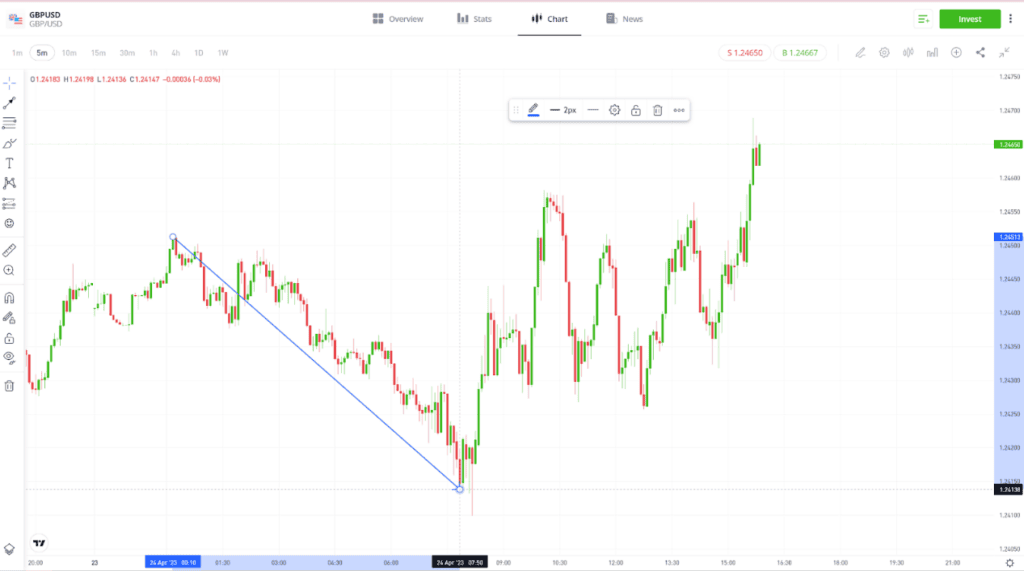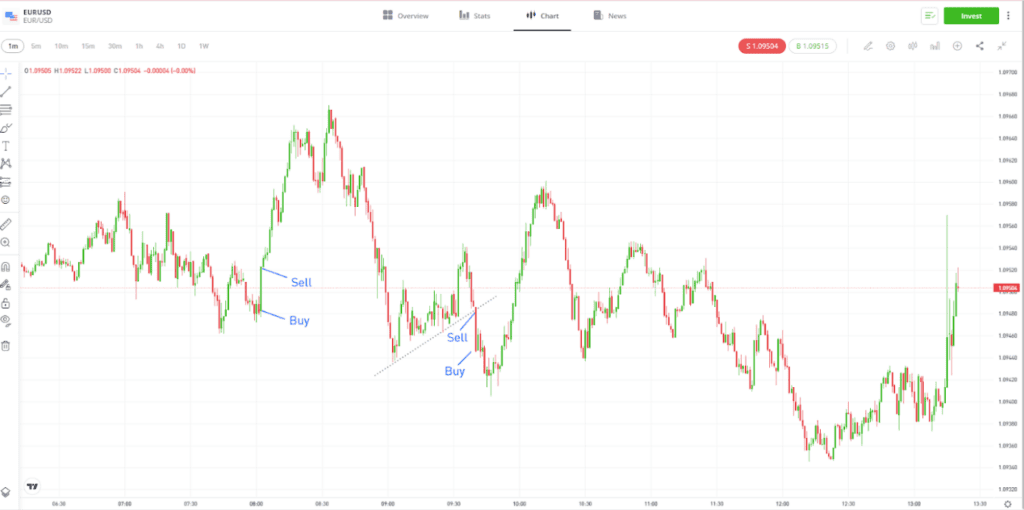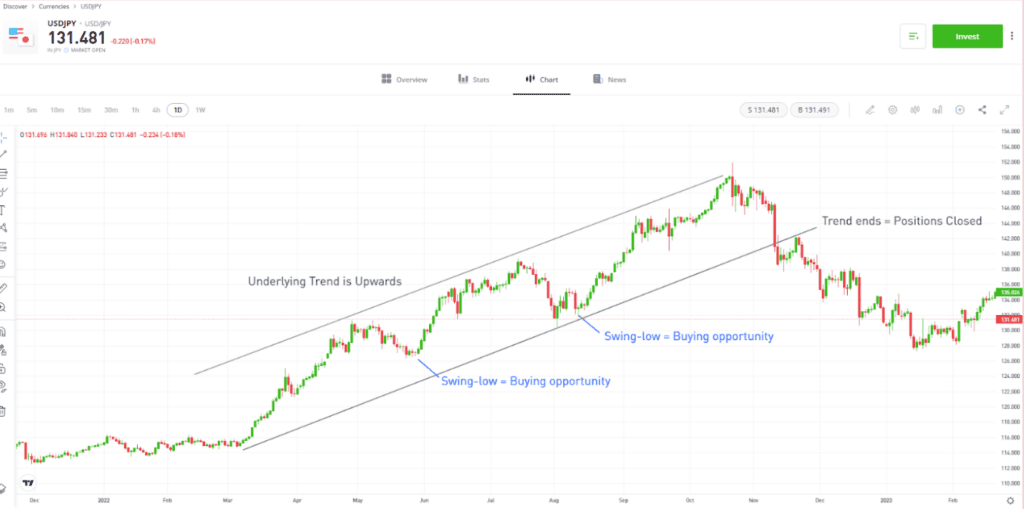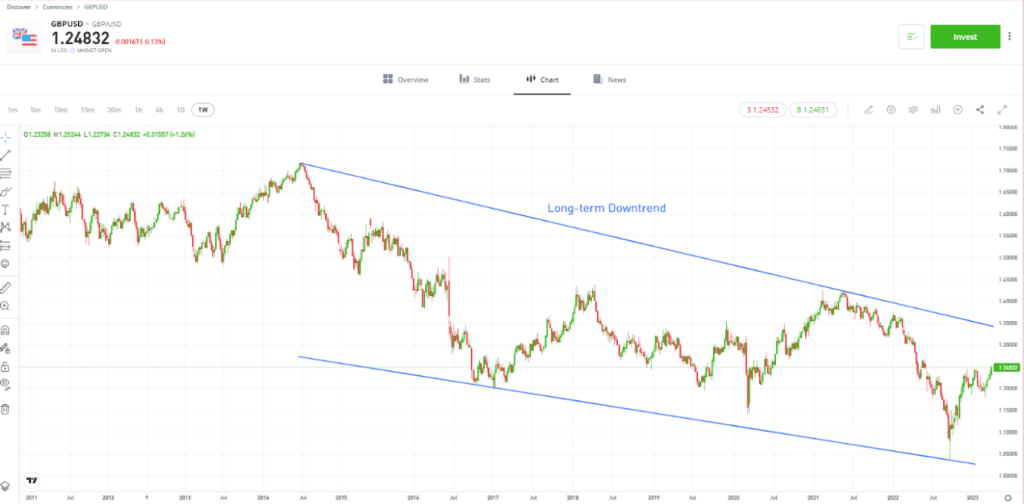In theory, forex trading can be easily understood, but it is difficult to master. To engage in forex trading, traders need to find the right forex strategy to suit their trading needs. Learn about forex scalping, swing trading and day trading. Discover how each approach works and decide which will best position you to meet your investment objectives.
Once you have understood the price movements of the forex markets, it’s important to develop a plan and adopt techniques to try and utilise those movements to your advantage. Adopting a strategy that includes trade entry and exit points, stop-losses and portfolio management protocols can help traders to approach the forex markets with greater discipline and professionalism.
Tip: Clear strategies can help traders to develop an investment mindset, outline a pathway towards positive returns and avoid emotional investing.

What is a forex trading strategy?
A forex trading strategy is a set of rules that determines the price level at which a trader executes a buy or sell trade, for how long they hold the position and when they close it out. The two main metrics to consider are price and time.
The fundamental principles of trading, such as “buy low, sell high,” still apply, but a strategy provides a framework and additional layers of planning to put traders in the best position to meet their investment aims.
Tip: Your choice of forex strategy will be heavily influenced by what you want to achieve, your intended time frame and the amount of time you can allocate to achieving your target.

Examples of forex trading strategies
Forex traders have developed a range of different strategies over time. Each one is designed to work in different market conditions, and certain strategies will be a better fit for some individuals than others, depending on how much time they are willing to devote to trading.
Tip: Studying historical price charts might help you to establish which forex strategies would have generated profits at a given time, but trading involves looking forward and picking the right strategy, for the right market, at the right time.
Forex day trading strategy
The key aspect of day trading is that all positions are closed out at the end of the trading session. Therefore, there is no risk carried overnight, even when a trader is not actively monitoring the markets. Forex day trading is a popular strategy. Forex day traders will often put on short-term trades based largely on technical analysis indicators that pinpoint moments when the price of a currency pair could move in one direction or another.
In the GBPUSD chart below, you can see the downtrend between 00:00 am and 07:50 am. Forex traders with open positions may not be monitoring these price movements actively at night. Day traders negate this risk by ensuring their positions are closed at the end of the trading day.
| GBPUSD – 5-minute price chart – Scalping strategy |

Past performance is not an indication of future results
Source: eToro
Tip: To avoid getting “stuck” in a loss-making position and closing it out near the end of the trading day, potentially for a significant loss, many day traders use stop-loss instructions. A stop-loss will close out a position that moves against you in order to limit losses.
Forex scalping strategy
Forex scalping strategies take advantage of forex market volatility and involve opening and closing trades in quick succession, with the intention of making a small return each time. The holding period is typically seconds or minutes.
Under eToro’s Terms and Conditions, scalping is a trading technique that is not permitted.
In order to learn more about this policy, please refer to our Terms and Conditions using the link.

Past performance is not an indication of future results
Source: eToro
Forex swing trading strategy
As with any asset, forex price charts don’t move in a straight line. Even if there is a strong upward or downward underlying trend, there will be peaks and troughs in the price of a currency pair as it moves to a new price level. Swing trading strategies aim to profit by entering into positions that buy the dips and sell the top, and holding them until the trend stalls.
| USDJPY – Daily price chart – Swing trading strategy |

Past performance is not an indication of future results
Source: eToro
Tip: Swing trading typically involves booking fewer trades and holding positions for longer. It is sometimes preferred by those with less time to spend monitoring the markets.
Forex position trading strategy
Position trading is a forex strategy that is more closely related to investing, rather than trading. Position trading involves taking a medium- to long-term view of the relative value of currencies using fundamental analysis and holding a position for weeks, months or years.
| GBPUSD – Weekly price chart – Position trading strategy |

Past performance is not an indication of future results
Source: eToro
Do more of what works and less of what doesn’t.
Steve Clark
How to develop your own forex trading strategy
Knowing which strategy to apply to which market, and at what time, is one of the major challenges facing forex traders. Even if a strategy is working today, it may not be effective tomorrow.
Using a demo account is a good way to establish which approach to use when trading the forex markets. It’s possible to run different strategies, in a range of currency pairs, using virtual funds. If a particular strategy works for you, you can then consider implementing it on a live account.
Flexibility is also important. A “paradigm shift” explains the moment market conditions change and, as a result, impact the likelihood of a particular strategy working. These events highlight the importance of reacting to risk factors, which are outside of a trader’s control, in order to try and optimise returns.
Although some factors cannot be influenced, it’s important to implement strategies that are a good fit for your personal circumstances. Be realistic about how much time you can devote to trading forex, and remember that certain strategies, such as day trading, are more labour-intensive than others.
Tip: Sometimes, a trading strategy is identified and implemented by so many traders that individuals will struggle to make worthwhile returns from it because of the combined trading activity. This strategy would be referred to as “crowded.”

Final thoughts
When trying to identify the best forex strategy for your personal trading style, it’s worth remembering that it is possible to run different types of forex strategies at the same time. Strategies operating on a shorter time frame could be run parallel to another, medium-term strategy, for example.
Traders will find that certain strategies suit them better than others, but it’s important to keep all options open and develop an understanding of how different strategies work, in order to potentially spot new trading opportunities. Remember, however, that all strategies come with some element of risk, so conduct thorough research before trading any currency pairs.
Visit the eToro Academy to learn more about forex trading and currency pairs.
Quiz
FAQs
- When are forex trade volumes highest?
-
Forex trade volumes and price volatility are typically higher when two of the world’s major forex trading centres are open at the same time. For example, both the London and New York markets operate between 13:00-17:00 GMT and 08:00-12:00 EST, and so this is a time of increased trading opportunities for short-term forex traders. Liquidity and volumes also tend to spike around the time of major news announcements.
- How many trades do day traders book each day?
-
The amount of trading activity is not a defining feature of day trading, and so those following a day trading forex strategy might put on a large or small number of trades. Day trading can help traders to manage risk by not holding positions overnight, and the holding period of each trade can range from seconds to hours.
- What causes FX rates to change?
-
Short-term price moves can often be explained by technical analysis, which identifies pricing anomalies based on markets not being as “efficient” as economic theorists would suggest. On the other hand, longer term price trends are more likely to be determined by fundamental factors, such as interest rates, inflation and geopolitical events, which can bring about more substantial movements in price.
This information is for educational purposes only and should not be taken as investment advice, personal recommendation, or an offer of, or solicitation to, buy or sell any financial instruments.
This material has been prepared without regard to any particular investment objectives or financial situation and has not been prepared in accordance with the legal and regulatory requirements to promote independent research. Not all of the financial instruments and services referred to are offered by eToro and any references to past performance of a financial instrument, index, or a packaged investment product are not, and should not be taken as, a reliable indicator of future results.
eToro makes no representation and assumes no liability as to the accuracy or completeness of the content of this guide. Make sure you understand the risks involved in trading before committing any capital. Never risk more than you are prepared to lose.


